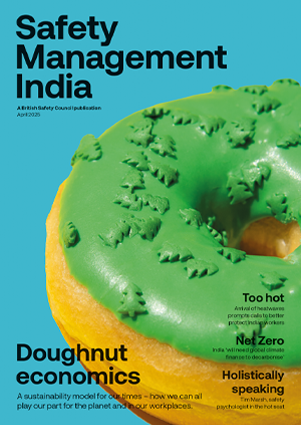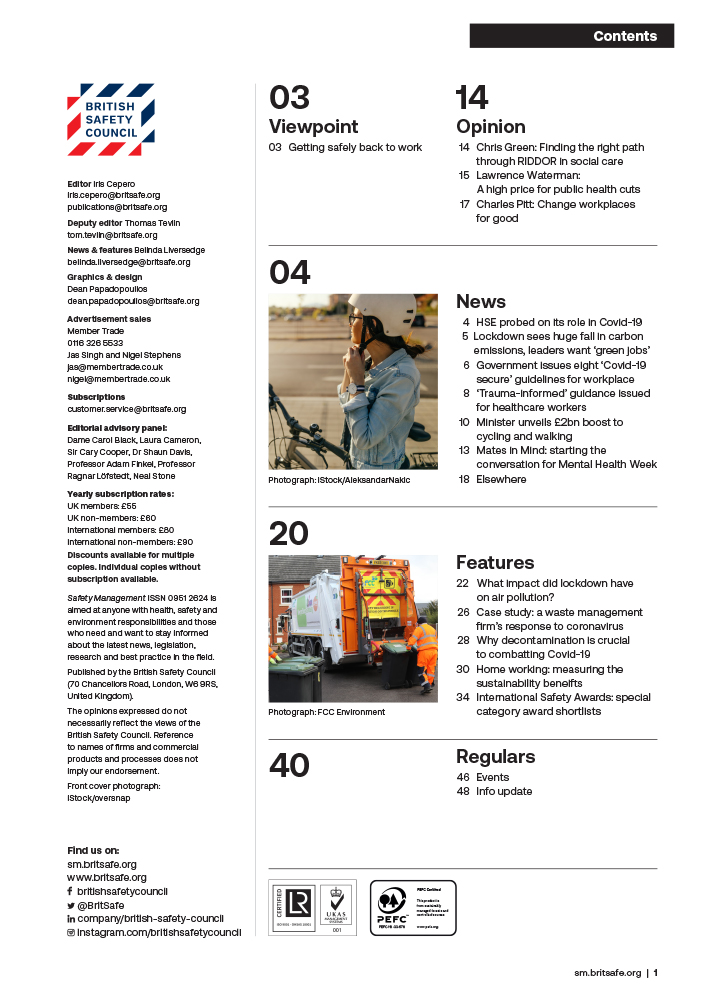Although India has made progress in banning the use of chemicals that pose a risk to workers’ health, there remains a long way to go to eradicate the danger.
Features
Chemicals in India: a cocktail of health risks
As India recently celebrated the festival of colour, medical experts warned that exposure to hazardous substances in synthetic Holi colour powders – like heavy metals, chemicals and pesticides – can have a devastating impact on a person’s skin, eyes and respiratory system.
Holi is celebrated once in a year – meaning any exposure to potentially harmful powders only occurs briefly. However, millions of Indians are exposed to hazardous chemicals in the workplace every day.
 Photograph: iStock - Credit Antoine2K
Photograph: iStock - Credit Antoine2K
In fact, hazardous chemicals are present everywhere – in the air, consumer products, water, soil and at the workplace. They can cause several diseases, including mental, behavioural and neurological disorders, cataracts and asthma.
Workers across India are facing a health crisis due to occupational exposure to toxic chemicals such as lead, mercury, manganese, chromium, cadmium, benzene, pesticides and asbestos. Large numbers of Indian workers lose their lives following exposure to these hazardous substances, succumbing to poisoning, cancer, disorders of the lung, kidney and liver or, suffering fatal injuries due to fires and explosions involving these agents.
The lives of workers and their families are also severely affected when workers develop debilitating and long-term diseases and injuries due to exposure to and incidents involving chemicals and other hazardous substances.
India’s chemical manufacturing and processing industry, which manufactures both basic chemicals and chemical-based substances – like petrochemicals, fertilisers, paints, pesticides, bulk drugs and pharmaceuticals – is one of the country’s most diverse industrial sectors, responsible for the creation of more than 70,000 commercial products containing or made from chemicals.
However, although India has over 15 Acts and 19 rules governing different aspects of the chemical industry, none of the laws have been designed exclusively for the chemical sector.
The Environment (Protection) Act, 1986, is currently the umbrella act for the chemical industry, according to the National Chemical Management Profile for India report, launched in 2005-06 by the Ministry of Environment, Forest and Climate Change (MoEFCC) and the Central Pollution Control Board (CPCB).
In the three years up to 2020, there were on average over four major chemical accidents every month at Indian chemical manufacturing plants. “The 152 recorded accidents [during the three years] are underestimated as most cases go unregistered,” said Gopal Krishna of Delhi-based non-profit organisation ToxicsWatch, which researches and reports on the health risks from hazardous substances in India.
Legal framework needed
A national chemical policy for India has been pending since 2012, and scientists say the country now needs a comprehensive legal framework to effectively regulate the production, use and safety of chemicals.
Krishna says India does not have adequate and appropriate knowledge about the chemicals that are being used in the country. “So, several chemicals that are banned internationally continue to be used here,” he warns.
According to 2021 estimates by the World Health Organization (WHO), deaths due to exposure to hazardous chemicals worldwide rose 29 per cent in 2019 compared to 2016.
Two million people lost their lives due to exposure to hazardous chemicals in 2019, compared to 1.56 million in 2016, according to the Geneva-based global health body.
The alarming estimates were released by Tedros Adhanom Ghebreyesus, WHO director-general, during the Ministerial Dialogue held in July 2021 at the Berlin Forum on Chemicals and Sustainability: Ambition and Action towards 2030.
A report from the UN Special Rapporteur on Human Rights and Hazardous Substances and Wastes, presented at the 39th session of the Human Rights Council in Geneva in 2018, found that around the world, workers are dying as a result of toxic exposure in the workplace at a rate of one every 30 seconds.
With 2.78 million deaths per year attributable to unhealthy or unsafe workplaces, the report warned that women, children, migrant workers and the poor are especially vulnerable to work-related fatalities, injuries and ill health, and that the solutions to solve this global crisis of public occupational health require the participation of business, governments and international organisations.
Most deaths due to exposure to hazardous chemicals are preventable, according to the WHO. They can be prevented by reducing or removing chemical exposure.
Lead poisoning
The WHO report warned that lead exposure – which can cause cardiovascular diseases (CVD), chronic kidney diseases and idiopathic intellectual disability – was estimated to be responsible for nearly 45 per cent (close to half) of the deaths due to exposure to hazardous chemicals around the world in 2019. In fact, various studies have found that poorly recycled lead batteries, e-waste, mining and paints are the main sources of lead poisoning.
Vehicle batteries are the prime culprit as nearly 85 per cent of all the lead used in the world goes to produce lead-acid batteries, and the vast majority of the lead exposure comes from recycled car batteries.
Lead, one of the most ubiquitous and poisonous metals, is also among the most recycled, with more than six million tons of it collected for re-use each year. Lead batteries are “the world’s most recycled consumer product”, according to the International Lead Association, a London-based trade body. Thanks to recycling, lead is barely mined anymore.
Doctors say that lead is readily breathed in or ingested, and then enters the bloodstream, which delivers it efficiently to organs ranging from the gastrointestinal system to the brain.
A study published in 2019 by Toxics Link concluded that nearly 90 per cent of lead batteries in India ended up being recycled by the informal sector. The study mapped neighbourhoods in major cities, such as Delhi, where workshops recycling lead batteries operate apparently with no official oversight.
However, the India Lead Zinc Development Association dismissed the Toxics Link study as “exaggerated and totally flawed”.
Lead is added to paints for various reasons, including enhancing the colour, reducing corrosion and decreasing the drying time. The Indian government has enacted rules to limit lead content in paints to a maximum of 90 parts per million. However, challenges remain around ensuring compliance with the rules, especially in small and medium-sized enterprises.
Meanwhile, mercury, a very toxic and dangerous substance, is a major environmental and public health concern. In September 2021, India imposed restrictions on imports of mercury, which is used in different items, including older thermometers, fluorescent light bulbs and electrical switches.
The risks to human health and the environment from mercury hit the headlines in India back in 2001 when several tonnes of glass waste contaminated with mercury were discovered in a forest near a factory owned by Hindustan Unilever, where thermometers containing mercury were manufactured for export.
Hindustan Unilever said a contractor had dumped the contaminated waste in contravention of the company’s rules, and the factory was closed in 2001 and remediation of the site has since taken place.
After the factory closed, a number of former workers alleged they had suffered signs of mercury poisoning. In 2016, the Hindustan Unilever announced that it had signed an out-of-court deal with hundreds of former employees to end the long-running dispute over the allegations of mercury poisoning. However, the case prompted widespread public debate in India around issues of corporate liability, corporate accountability and alleged corporate negligence.
Arsenic exposure
For millions of people across India, the source of chronic arsenic toxicity is usually unclear, and may be due to unknown environmental, occupational or medicinal exposures. One industrial activity that poses an increased risk of arsenic exposure for workers is mining, since arsenic is an element that co-exists with gold, cobalt, zinc, lead, and coal.
Scientists found high levels of arsenic in the soil and groundwater near a gold mine in Karnataka, highlighting the health hazards associated with mining the precious metal. The Kiradalli Tanda village of Yadgir, which is four kilometres from a gold mine, has reported several cases of suspected arsenic-induced skin diseases and cancers.
There is also an increased risk of arsenic toxicity during the smelting of non-ferrous metal ores, as the process produces an arsenic by-product.
Also, in the last 10 years, 130 major chemical accidents have been reported in all types of Indian businesses and industries, resulting in 259 deaths and leaving 563 people with serious injuries, according to data collected by the National Disaster Management Authority (NDMA).
One of the latest incidents occurred in January this year at the Sachin Gujarat Industrial Development Corporation in Surat, after hazardous chemical waste was allegedly dumped in a drain. Workers sleeping nearby inhaled the poisonous fumes and six of them died while another 20 people were hospitalised.
Pesticide poisoning
In a comprehensive study published recently, scientists estimated that about 385 million people, particularly farmers and agriculture workers, are poisoned by pesticides every year around the world. These incidents result in around 11,000 deaths per year, nearly 60 per cent of which occur in India, according to the research.
Two of the pesticides blamed for these deaths – monocrotophos and oxydemetonmethyl – are classified as Class I pesticides by the WHO, and exposure to even small amount of these pesticides can be lethal. Data from India’s Directorate of Plant Protection, Quarantine and Storage shows that Class 1 insecticides account for 30 per cent of the insecticides used in India.
Many foreign countries have banned these deadly pesticides. Phosphamidon is banned in 49 countries, Phorate in 37, Triazophos in 40 and Monocrotophos is banned in 60 countries.
The Indian government and authorities now seem to have concluded that it is time for India to follow the lead of other countries and introduce a ban on these pesticides. As a result, the government is considering banning as many as 27 pesticides and has appointed an expert committee to look into this issue, Narendra Singh Tomar, Union Minister for Agriculture and Farmers’ Welfare, told the Rajya Sabha in July 2021.
Meanwhile, Ladakh soon intends to ban the use of chemicals, fertilisers and pesticides in the region, according to a recent announcement by the UT Secretary Ravinder Kumar.


FEATURES

India’s path to net zero: a work in progress
By Orchie Bandyopadhyay on 08 April 2025
India is implementing a variety of clean energy measures to hit its target of net zero greenhouse gas emissions by 2070, including plans to rapidly scale up the generation of nuclear power. However, climate experts say significant finance will be required from developed countries to phase out coal power, accelerate renewables deployment and expand the national electricity grid.

Too hot to handle: early arrival of heatwaves in India sparks calls for action to protect workers and the public
By Orchie Bandyopadhyay on 08 April 2025
Temperatures in India in February 2025 were the hottest since records began over a century ago, prompting warnings the country needs to urgently step up efforts to protect both workers and the general population from the health risks posed by extreme heat and humidity.

